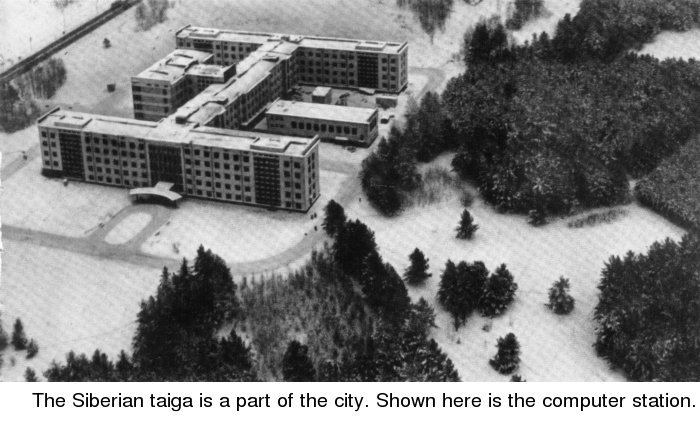Siberia is a vast geographical region. However, this land has had its own capital of sorts for centuries. At first, it was the town of Tobolsk, while Omsk was still a village. Then the railroad brought Omsk and Irkutsk to the fore and doomed Tobolsk to provincial obscurity. Novosibirsk, which also flourished after the railroad was built, had a population of seventy thousand in 1917, the year of the Revolution. Today, this is a city of over a million people. Its industrial might, cultural significance and location justify its claim to being the uncrowned capital of Siberia. The satellite city which has grown up beside it has done much to support this claim.
Actually, the satellite city can also be considered a capital, for it was planned as the scientific center of Siberia. Akademgorodok is known far beyond the boundaries of Siberia, as is its age: it is fifteen years old. The city is still growing and now has a population of forty thousand. One-seventh of the population are scientists, including 150 Doctors of Science and 60 Academicians. What other Soviet city besides Moscow can boast of such a scientific force?
As to the city's appearance, anyone who has seen the second-best housing in the South-Western District of Moscow can picture the city blocks here. They went up at a time when the architect's role was minimal in our construction projects. This error is now being rectified. However, while being a child of its time, the city still managed to escape the regrettable fate of being rubber-stamped. It has a personality of its own. Having once visited it, you will not forget the streets that resemble a cutting in a forest, or the light in the windows, viewed through the lacy branches of the birch trees. From above you can see how well the streets and houses blend in with the surrounding taiga. When a person here goes out for a walk he is practically in the woods. When he goes skiing on a weekend the trail begins at his doorstep. Mushroom picking in summer can be done within sight of one's house. Mothers and children feed wild squirrels on the streets, and there are special feeding stations in many spots. I counted seven squirrels near one on a frosty day. They spiralled down the pine trunks, took crackers from the children's hands, perched on their shoulders and climbed into shopping bags. Squirrels are frequent visitors on every balcony. Even the most engrossed physicist becomes more lyrically inclined here.

What is life like here? What do the people do? It is quite impossible to even list the problems the atomic physicists, geneticists, mathematicians, chemists, geophysicists, archeologists and hydraulics engineers of the two dozen research institutes are working on. Academician Lavrentyev, the "city father", said: "There are no rigid partitions that separate one science from another. Most often the big breakthroughs occur at a point where the various sciences meet. It is of paramount importance for scientists to be able to associate with each other constantly." Not all ideas are born in laboratories. Sometimes a discussion during a walk or over a cup of coffee will be of more help to a scientist than an international congress, while notes jotted down on a paper napkin may be the beginning of a great discovery. The close proximity of many institutes and the fact that scientists in various fields live in the same apartment house is extremely beneficial to scientific progress. "One stick of firewood won't burn, but if we all get together it'll be a regular bonfire," one of the early backers of the idea of creating such a city said. The torch was set to the bonfire, and with each passing year the flames have grown brighter.
How effective are the results? Academician Lavrentyev said: "The establishment of this center has proved to be most profitable. Though we're still in the growing stage, a rough totalling shows we've already paid our way four times over." Among the many discoveries and projects are the Siberian oil fields, the application in industry of the results obtained by the Siberian school of mathematics, new hydrotechnical equipment and new breeds of valuable fur-bearing animals.
I would like to add a few words about the tempo of life here and the prevailing spirit. A visitor for a day will do well if he manages to inspect the exterior of the many research institutes. Yet, even a day will suffice to observe that this is a city of lively, interesting people. The community center is known as Under the Integral and is run by a president and ministers. This is not merely a place for dancing or listening to a lecture. Here one can find friends to his liking. The heated debates are always on topical problems. During the voting for Miss Integral it was discovered that one of the contestants was a young man in drag. The Babylon Club members study languages, while the Quill Club harbors budding writers. One has to be a true cinema buff to join the Sigma Club, where the board of examiners will sometimes pass a student and flunk an academician. Here are two excerpts from the log of a carnival: "A young physicist reached the prize boots at the top of a pole in a flash", and "a physicist and Lenin Prize winner was responsible for the fireworks". There was a troika, a Gypsy camp, a campfire, traditional blini and potatoes roasted in the coals.
The most popular activities are fishing, skiing, mountain-climbing, music, swimming in ice-holes in the river in winter, ice-skating, poetry recitals and hunting. Indeed, science is being advanced by lively, interesting men and women.
